Table of Contents
- Introduction
- Editor’s Choice
- Global Employee Wellbeing
- Wellbeing Priorities of Employee
- Employees’ Sense of Wellbeing from Their Organization Worldwide
- Perception of Organizational Wellbeing Support Among Employee
- Employee Positive Perceptions of Their Wellbeing
- Perception of Employees on Physical and Mental Wellbeing
- Positive Perceptions of Employee Wellbeing
- Satisfaction of Employees with Their Financial Situation
- Employees’ Sense of Appreciation at Their Organization
- Employees’ Sense of Success from Their Organization Worldwide
- Impact of Company Culture and Environment On Employee Wellbeing
- Employee Wellbeing Initiatives
- Impact of COVID-19
- Suggestions and Solutions to Support Employee Wellbeing
Introduction
According to Employee Wellbeing Statistics, Employee wellbeing is crucial for organizational success, encompassing physical, mental, and emotional health.
It begins with providing a safe, ergonomic workplace and promoting regular breaks and physical activity. Supporting mental health involves reducing stigma, offering counseling, and promoting work-life balance.
A positive workplace culture fosters well-being through open communication, recognition, and fair policies.
Professional development opportunities and competitive benefits further enhance job satisfaction. Leadership plays a key role by modeling healthy behaviors and supporting well-being initiatives. While feedback mechanisms help assess and improve well-being programs.
This holistic approach ensures a supportive environment where employees thrive, benefiting both individuals and the organization as a whole.
Editor’s Choice
- The global corporate wellness market size is expected to be worth around USD 100.8 Billion by 2032 from USD 56.63 Billion in 2022. Growing at a CAGR of 6.1% during the forecast period from 2022 to 2032.
- The share of the global workforce who reported thriving at work and in life reached 34% In 2023.
- In 2020 and 2021, U.S. employees prioritized various well-being activities in their personal lives with notable consistency and some shifts. Staying within a budget was a top priority, with 83% in 2020 and 81% in 2021.
- In 2023, a survey assessing the sense of well-being among employees from various countries revealed notable differences. Brazil led, with 64% of respondents reporting a sense of well-being from their organization.
- In 2022, the percentage of employees who rated their overall well-being positively varied across select countries worldwide. In the United States, 53% of employees reported a positive sense of well-being, the highest among the surveyed countries.
- In 2023, the sense of success felt by employees from their organizations varied widely across the globe. India topped the list, with 83% of employees feeling a sense of success.
- In 2022, the perceived attractiveness of companies due to their well-being benefits and programs varied across select countries worldwide. Overall, 35% of employees globally stated that such benefits made their company more attractive to potential employees.
- Since the coronavirus outbreak in 2020, a significant percentage of workers have reported various mental health challenges impacting their productivity. Approximately 28.3% of respondents noted difficulty concentrating, while 20% reported that tasks took longer to complete.
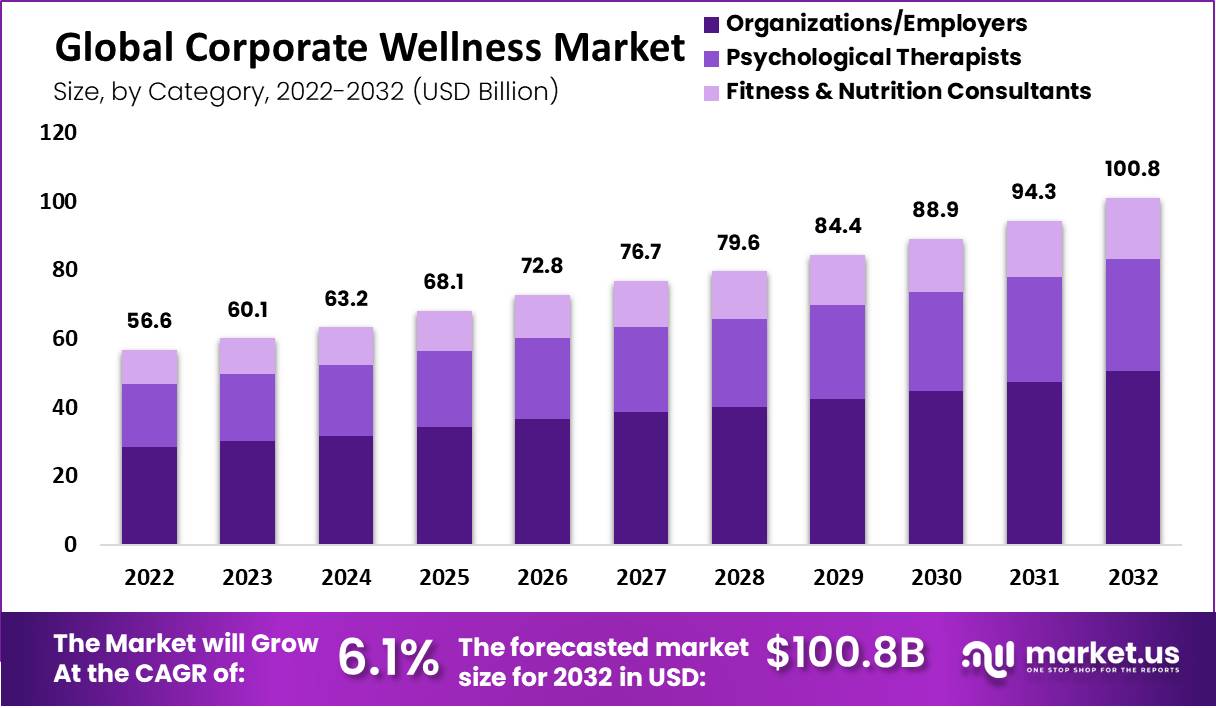
Global Employee Wellbeing
- From 2009 to 2023, the share of the global workforce who reported thriving at work and in life exhibited significant fluctuations.
- In 2009, 24% of employees felt they were thriving, but this figure sharply dropped to 13% in 2010.
- By 2012, there was a substantial rise to 31%, which slightly decreased to 30% in 2013.
- The upward trend continued with 33% in 2021, peaking at 35% in 2022 before a slight decrease to 34% in 2023.
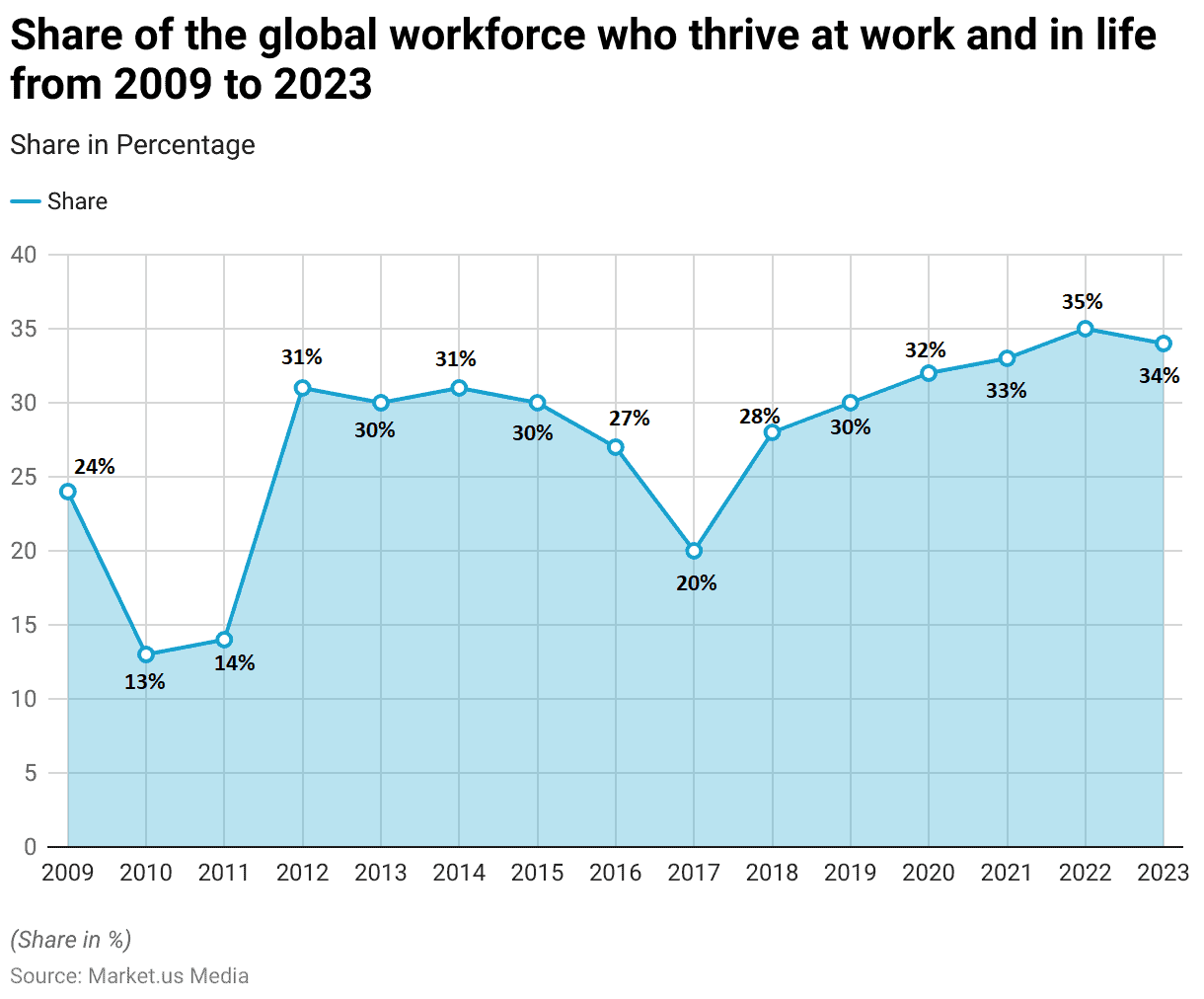
Wellbeing Priorities of Employee
- In 2020 and 2021, U.S. employees prioritized various well-being activities in their personal lives with notable consistency and some shifts.
- Staying within a budget was a top priority, with 83% in 2020 and 81% in 2021. Eating healthy remained stable at 81% across both years.
- Balancing work and personal commitments saw a slight increase from 77% in 2020 to 79% in 2021.
- Getting enough exercise and managing stress also rose, from 74% to 76% and 73% to 75%, respectively.
- Prioritizing retirement income or wealth accumulation decreased from 79% in 2020 to 74% in 2021.
- Similarly, the importance of growing and maintaining relationships dropped from 75% to 73%.
- Consistently, 72% of employees focused on building an emergency fund in both years.
- The importance of routine medical screenings increased marginally from 70% to 71%. While spending time on personal interests remained constant at 71%.
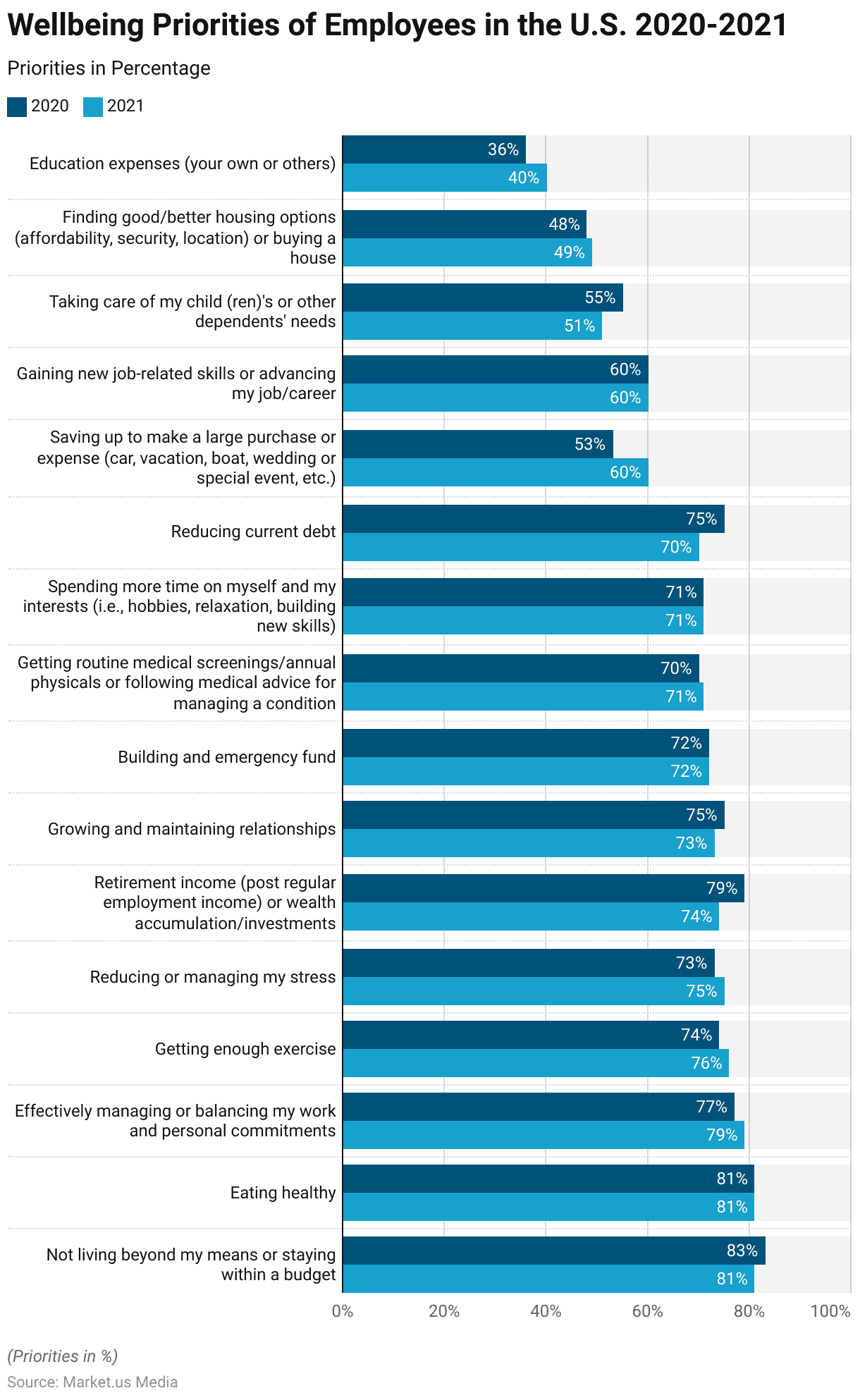
Employees’ Sense of Wellbeing from Their Organization Worldwide
- In 2023, a survey assessing the sense of well-being among employees from various countries revealed notable differences.
- Brazil led with 64% of respondents reporting a sense of well-being from their organization. Followed closely by South Africa at 62% and the Philippines at 61%.
- Mexico recorded a 60% satisfaction rate, while Italy followed with 57%.
- The United Kingdom, Canada, Chile, Germany, the United States, and China each reported 56%, indicating a moderate level of employee wellbeing.
- India and the United Arab Emirates shared a 55% satisfaction rate, paralleled by Argentina.
- In France and Australia, 54% of employees felt a sense of well-being. Whereas South Korea and Japan reported slightly lower figures at 53% and 52%, respectively.
- Saudi Arabia had a 51% satisfaction rate, and Singapore concluded the survey with 50% of respondents feeling a sense of well-being in their organization.
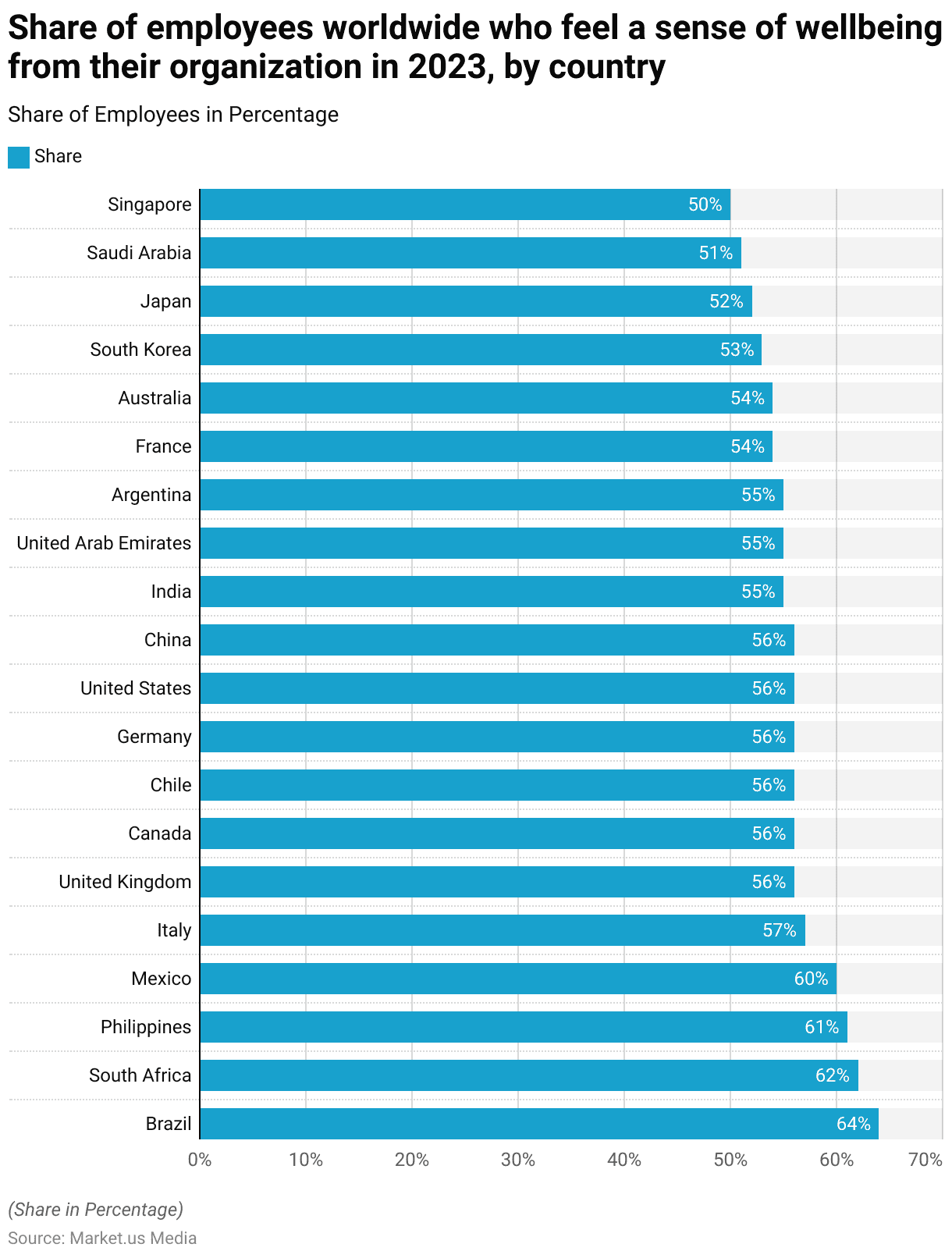
Perception of Organizational Wellbeing Support Among Employee
- Between May 2019 and February 2023, the percentage of employees in the United States who felt their organization cared about their well-being experienced notable changes.
- In May 2019, only 29% of employees felt cared for by their organization.
- This perception improved significantly by April 2020, reaching 48%.
- By February 2023, the percentage stood at 25%, indicating a general decline in employees’ perception of their organization’s care for their well-being over the observed period.
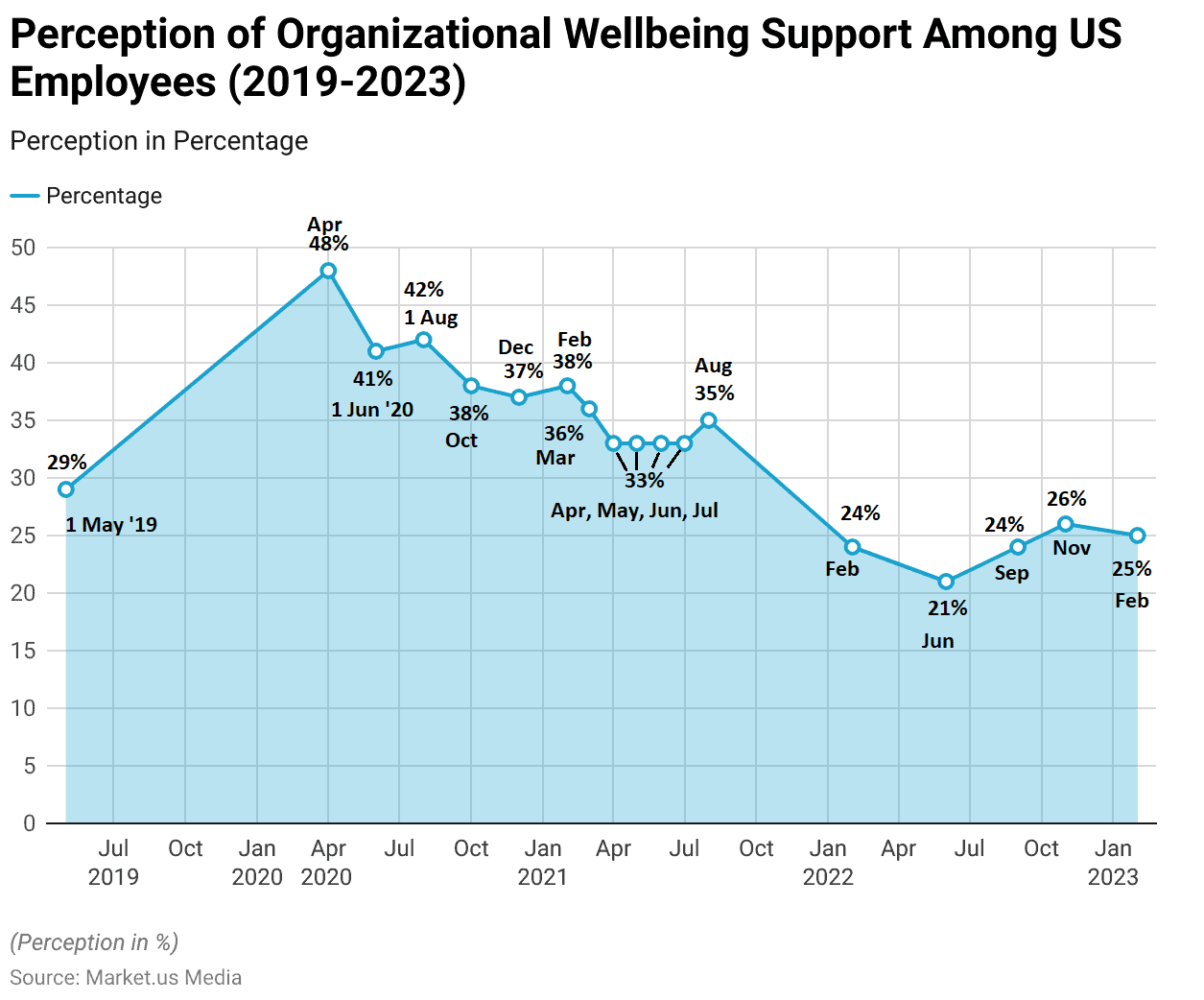
Employee Positive Perceptions of Their Wellbeing
- Employees’ positive perceptions of their well-being have varied across different aspects from 2018 to 2021.
- In 2021, 40% of employees felt positive about their overall wellbeing, slightly up from 39% in July 2020, but down from 49% pre-COVID-19 in 2020.
- Mental and emotional well-being was rated positively by 39% in 2021, compared to 37% in July 2020 and 46% pre-COVID-19 in 2020.
- This was a decline from 43% in 2019 and 49% in 2018.
- Social wellbeing saw a similar trend, with 38% positivity in 2021, increasing from 33% in July 2020 but decreasing from 45% pre-COVID-19 in 2020, 34% in 2019, and 35% in 2018.
- Physical wellbeing was positively perceived by 39% in 2021, up from 38% in July 2020, yet down from 44% pre-COVID-19 in 2020, 42% in 2019, and 43% in 2018.
- Professional and career well-being received a 36% positive rating in 2021, compared to 34% in July 2020 and 44% pre-COVID-19 in 2020, which was a decline from 39% in 2019 and 40% in 2018.
- Financial well-being was rated positively by 35% in both 2021 and July 2020, down from 40% pre-COVID-19 in 2020 but similar to 34% in 2019 and 35% in 2018.
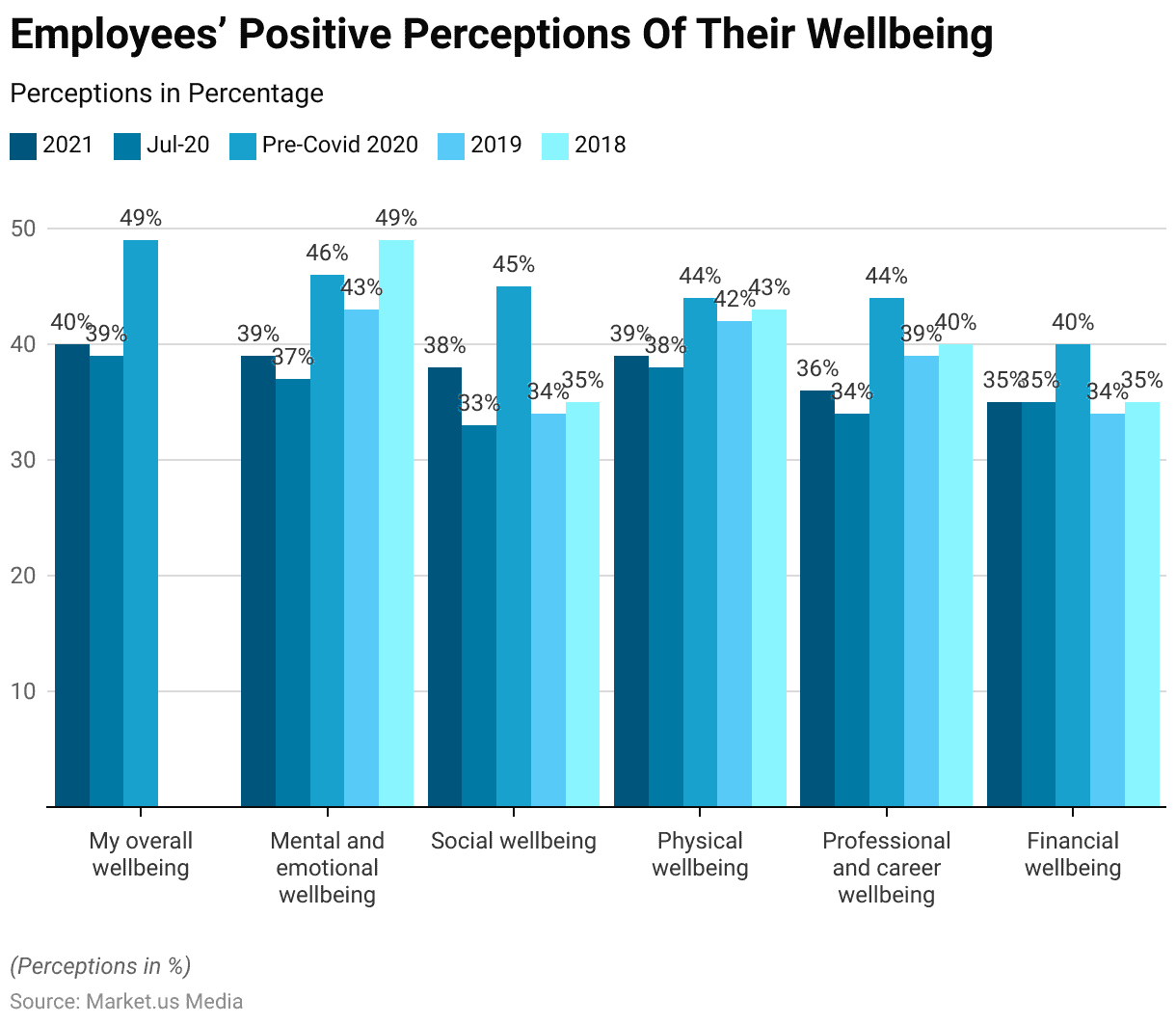
Perception of Employees on Physical and Mental Wellbeing
- As of 2022, the perception of U.S. employees regarding their employer’s concern for their overall mental health and physical well-being varied significantly.
- 6% of employees felt that their employer did not care about their well-being at all. While 10% believed their employer cared very little.
- A larger portion, 27%, felt that their employer somewhat cared about their well-being.
- Additionally, 32% of employees perceived that their employer cared a moderate amount, and 25% felt that their employer cared a great deal about their overall mental health and physical well-being.

Positive Perceptions of Employee Wellbeing
Employees Worldwide Who Rate Their Overall Wellbeing Positively
- In 2022, the percentage of employees who rated their overall well-being positively varied across select countries worldwide.
- In the United States, 53% of employees reported a positive sense of well-being, the highest among the surveyed countries.
- The Netherlands followed with 46%, while Germany had 44% of employees feeling positively about their wellbeing.
- In the United Kingdom, 40% of employees rated their wellbeing positively.
- France had the lowest percentage, with only 35% of employees expressing a positive perception of their overall well-being.
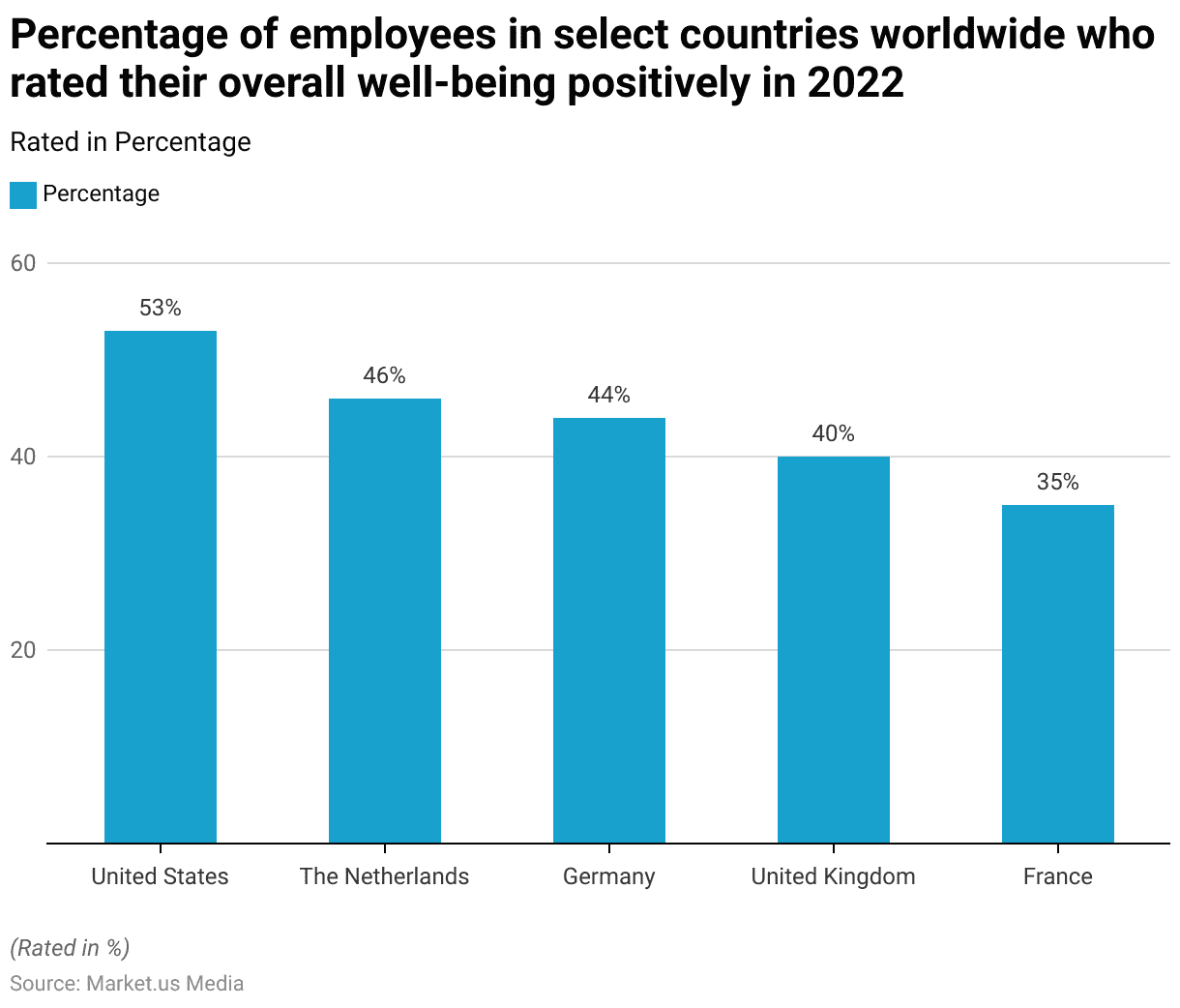
Satisfaction of Employees with Their Financial Situation
- In 2018, the satisfaction of employees in the United States with their financial situation showed a range of opinions.
- 15% of respondents reported being very satisfied with their financial situation, while 47% were somewhat satisfied.
- On the less positive side, 28% of employees felt somewhat dissatisfied, and 9% were very dissatisfied with their financial situation.
- Additionally, 1% of respondents indicated they did not know or had no opinion on the matter.
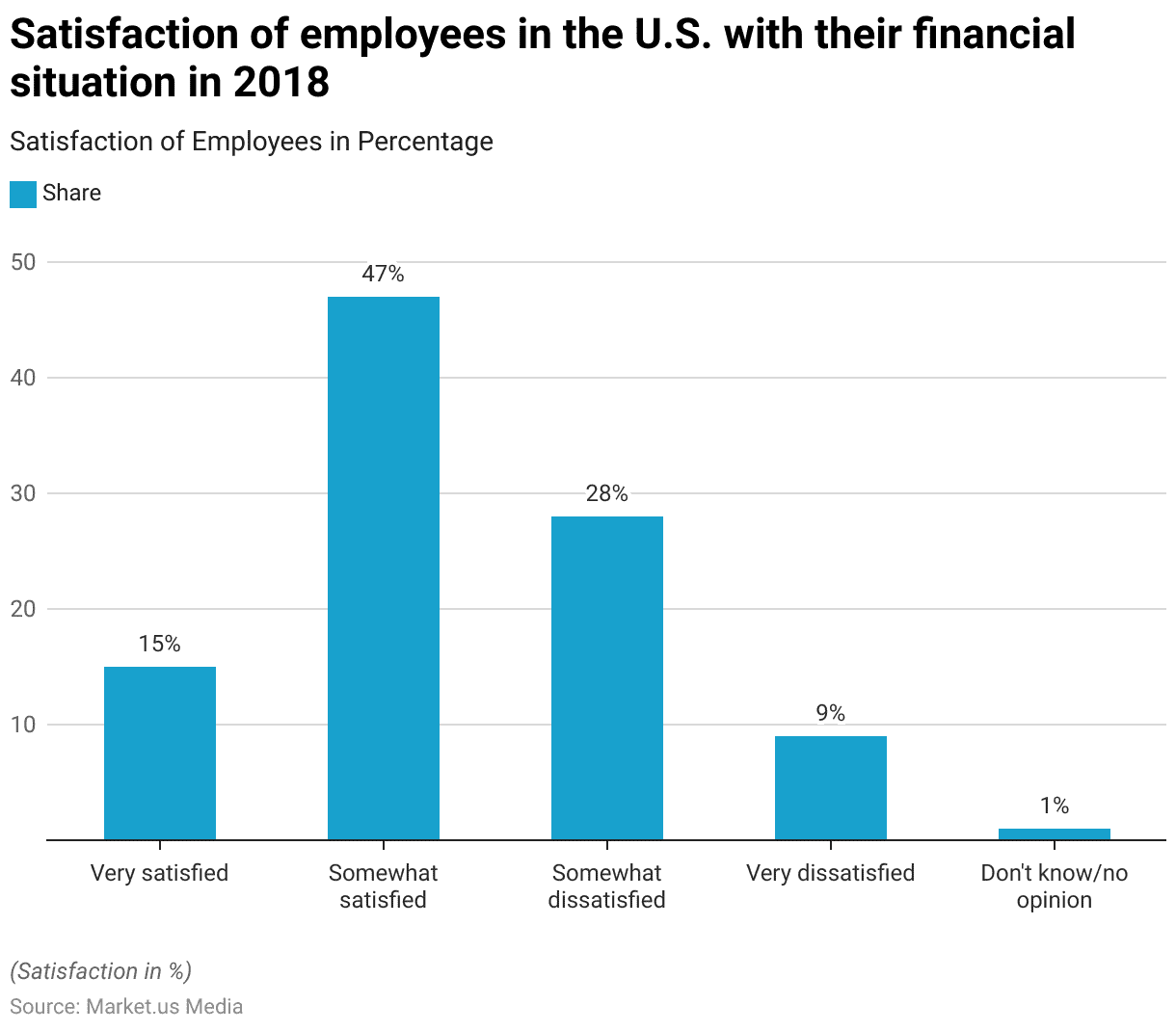
Employees’ Sense of Appreciation at Their Organization
- In 2023, the sense of appreciation felt by employees at their organizations varied globally.
- Brazil led with 70% of respondents feeling appreciated, followed closely by the Philippines, China, and India, each at 69%.
- In South Africa, 68% of employees reported a sense of appreciation, while in the United States, this figure was 66%.
- The United Arab Emirates and Saudi Arabia both had 65%.
- Canada and Mexico each reported 61%, and South Korea had 60%.
- In Singapore, Australia, and Chile, 59% of employees felt appreciated, while in Germany and the United Kingdom, the figure was 58%.
- France and Italy followed with 57% and 56%, respectively.
- Argentina had 55%, and Japan had the lowest sense of appreciation among employees, at 52%.
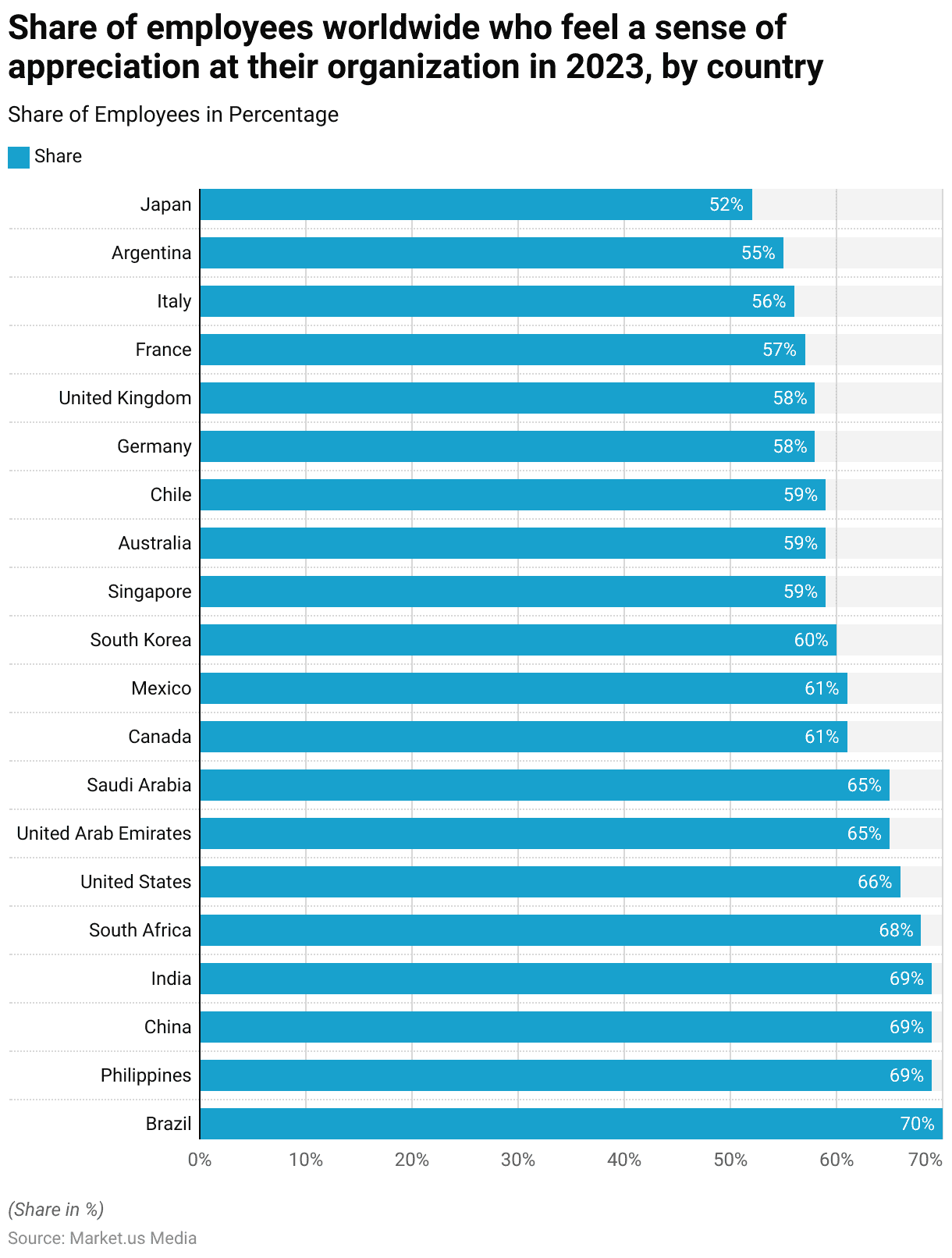
Employees’ Sense of Success from Their Organization Worldwide
- In 2023, the sense of success felt by employees from their organizations varied widely across the globe.
- India topped the list, with 83% of employees feeling a sense of success.
- The Philippines, China, Brazil, and the United States each had 77% of respondents reporting a sense of success.
- In Saudi Arabia, this figure was 76%, followed by the United Arab Emirates at 75% and South Africa at 74%.
- Mexico reported 71%, while Canada and Singapore each had 67%.
- In Chile and Australia, 65% of employees felt successful, and in the United Kingdom, the figure was 64%.
- Germany reported 62%, followed closely by Italy at 61% and France and Argentina at 60% each.
- South Korea had 58% of employees feeling successful, and Japan had the lowest percentage, with only 49% of employees feeling a sense of success in their organization.
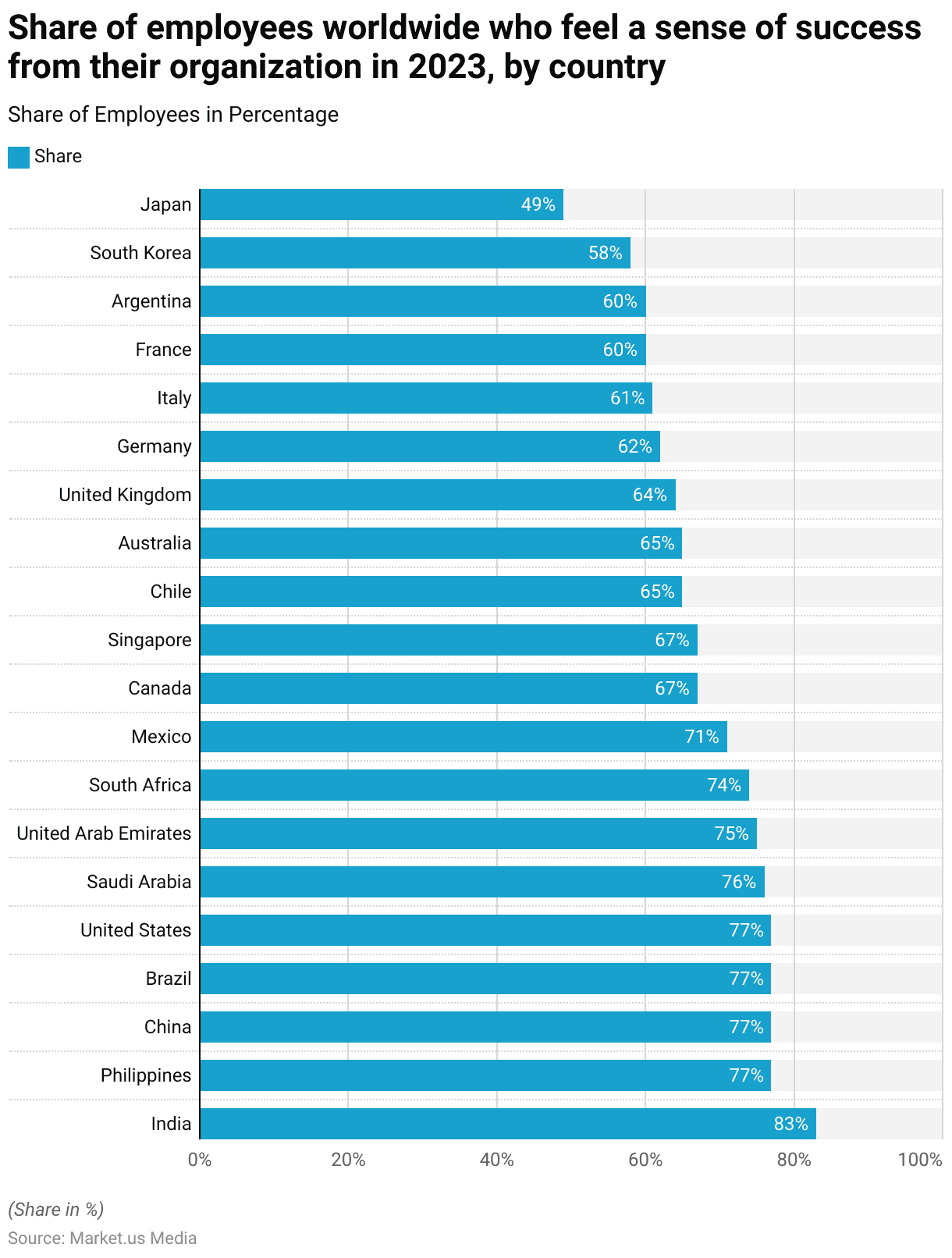
Impact of Company Culture and Environment On Employee Wellbeing
- In 2021, the impact of company culture and environment on overall well-being varied across different age groups.
- Globally, 18% of employees felt that their company culture contributed very positively to their well-being, while 32% felt it was somewhat positive.
- Among Gen Z employees, 14% reported a very positive impact, 35% somewhat positive, 35% no real impact, 14% somewhat negative, and 2% very negative.
- Emerging millennials had a more positive outlook, with 19% feeling very positive and 35% somewhat positive, while 31% saw no real impact, 12% felt somewhat negative, and 4% very negative.
- Established millennials reported the highest very positive impact at 24%, with 31% somewhat positive, 31% no real impact, 10% somewhat negative, and 4% very negative.
- Gen X employees mirrored the global average closely, with 18% very positive, 30% somewhat positive, 34% no real impact, 14% somewhat negative, and 5% very negative.
- Boomers reported the lowest very positive impact at 14%, with 29% somewhat positive, 37% no real impact, 14% somewhat negative, and 7% very negative.
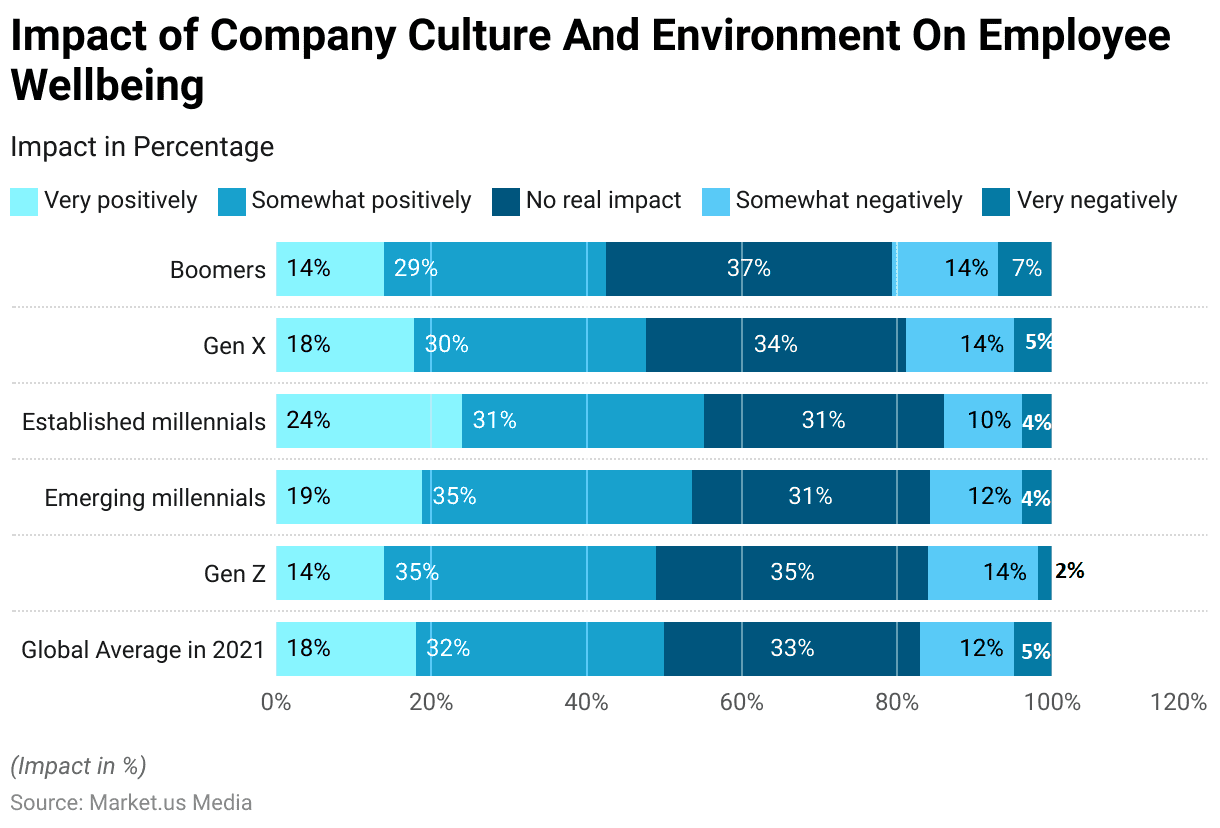
Employee Wellbeing Initiatives
Employees Opinions About Employer Wellbeing Programs
- From 2019 to 2021, U.S. employees increasingly appreciated the well-being programs offered by their employers, with positive sentiments growing each year.
- In 2019, 81% of employees found these programs easy to access when needed, a figure that rose to 84% in 2020 and 85% in 2021.
- The percentage of employees who felt these programs made them feel better about their employer increased from 78% in 2019 to 80% in 2020 and further to 84% in 2021.
- The perception of these programs as a good business investment also grew, from 80% in 2019 to 81% in 2020 and 84% in 2021.
- Employees also increasingly believed that wellbeing programs made their company more attractive to potential employees, with agreement rising from 78% in 2019 to 81% in 2020 and 83% in 2021.
- The programs were seen as enhancing overall engagement experiences, with 77% agreeing in 2019, 81% in 2020, and 83% in 2021.
- Furthermore, 75% of employees in 2019 felt the programs were effective in helping them create a better financial future, which increased to 79% in 2020 and 82% in 2021.
- The belief that these programs helped employees avoid getting sick grew significantly from 68% in 2019 to 70% in 2020 and 79% in 2021.

Employer Opinion On Positive Impacts of Company Wellness Programs
- From 2015 to 2019, U.S. employers consistently reported positive impacts of their company’s health and wellness programs across various metrics.
- In 2015 and 2016, 82% of employers observed improvements in workers’ health, and 80% noted enhanced productivity and performance. Healthcare costs are positively impacted by 71% and 72% of employers, respectively.
- By 2019, the positive impacts were more pronounced, with 83% of employers reporting better worker health. 84% noting enhanced productivity and performance, and 72% recognizing reductions in healthcare costs.
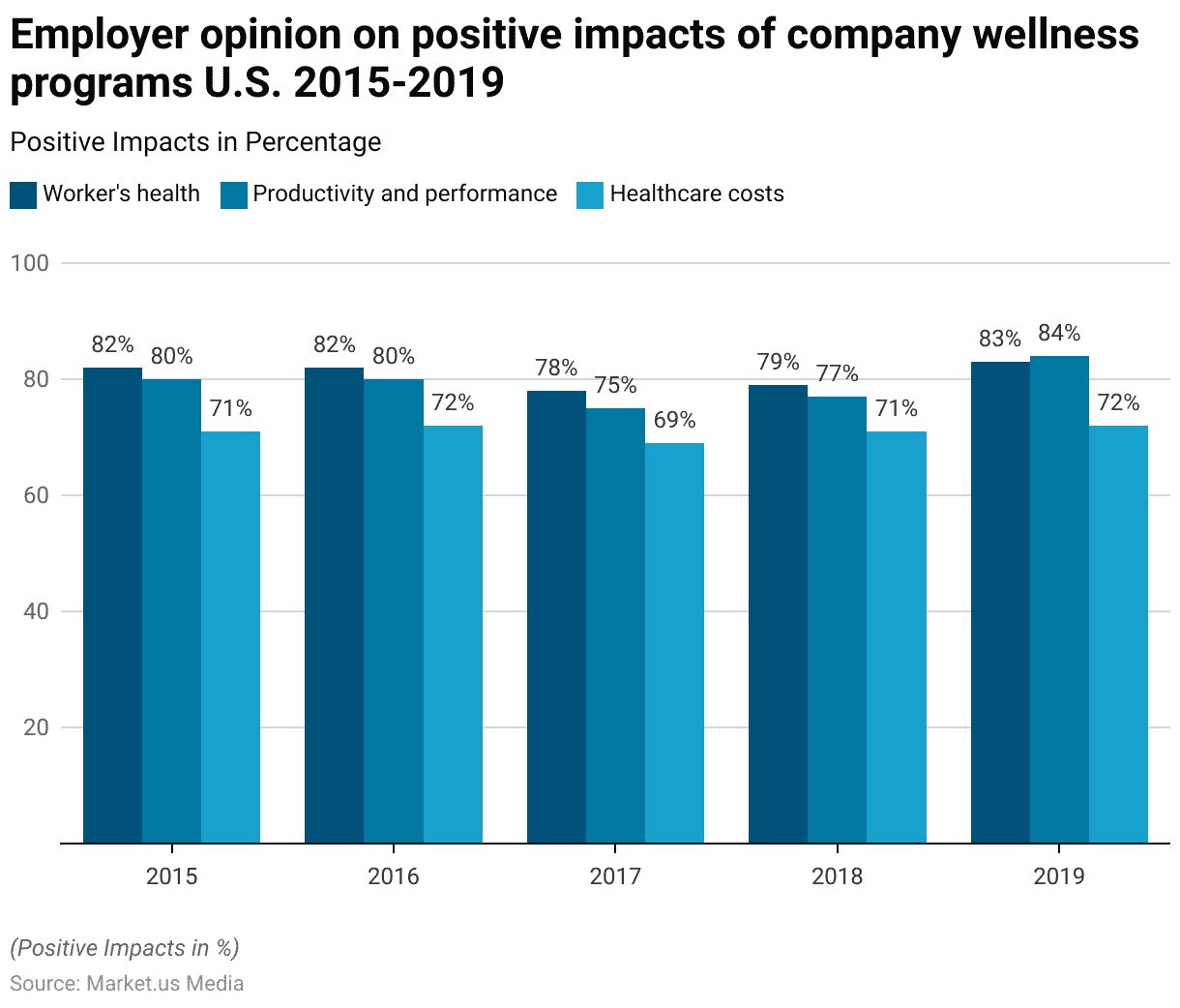
Impact of COVID-19
Workers’ Mental Challenges to Productivity Since COVID-19 Outbreak
- Since the coronavirus outbreak in 2020, a significant percentage of workers have reported various mental health challenges impacting their productivity.
- Approximately 28.3% of respondents noted difficulty concentrating, while 20% reported that tasks took longer to complete.
- About 14.7% struggled with thinking, reasoning, or decision-making, and 12.4% admitted to procrastinating on challenging work.
- Additionally, 11.8% of workers found it difficult to manage multiple tasks or responsibilities effectively.
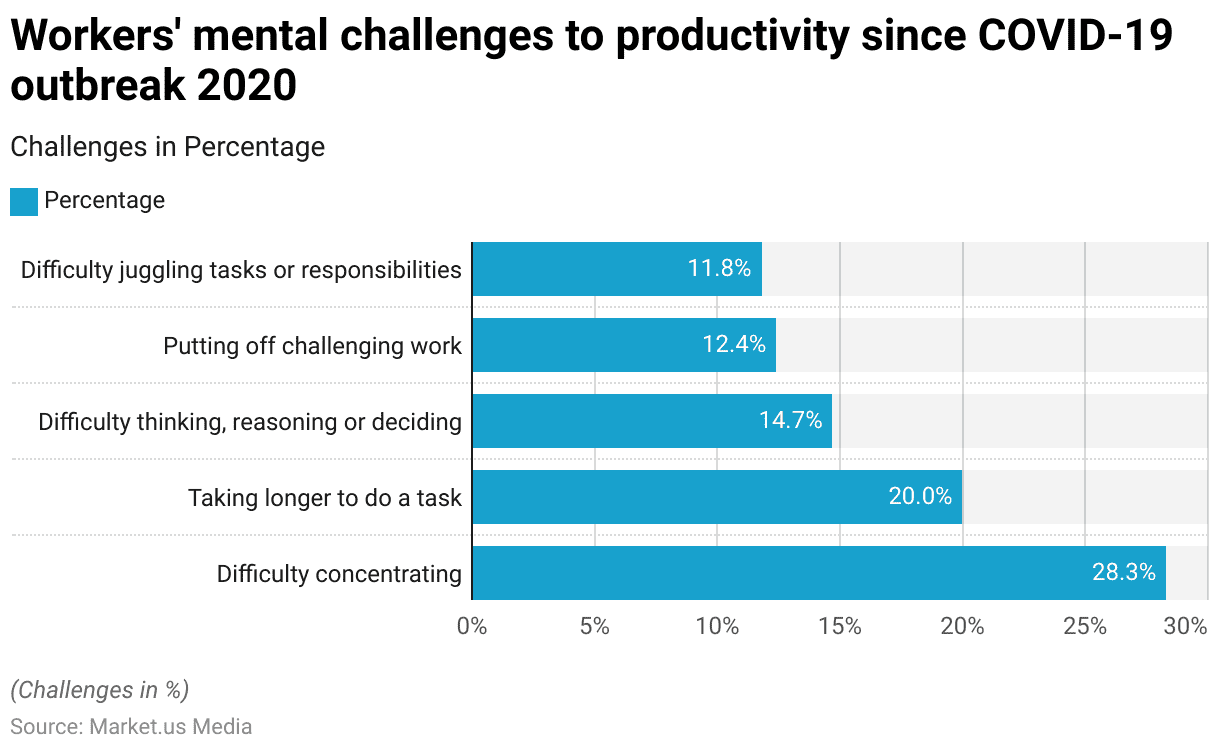
Suggestions and Solutions to Support Employee Wellbeing
- In uncertain times, seeking input from employees about the support they desire is crucial. Research by the American Psychological Association (APA) revealed that among 12 possible supports, the most favored were flexible work hours, preferred by 41% of respondents.
- Additionally, 34% valued a hybrid workplace environment that honors time off, while 33% sought remote work options.
- Another popular choice was a four-day workweek, which appealed to 31% of those surveyed.
Discuss your needs with our analyst
Please share your requirements with more details so our analyst can check if they can solve your problem(s)



